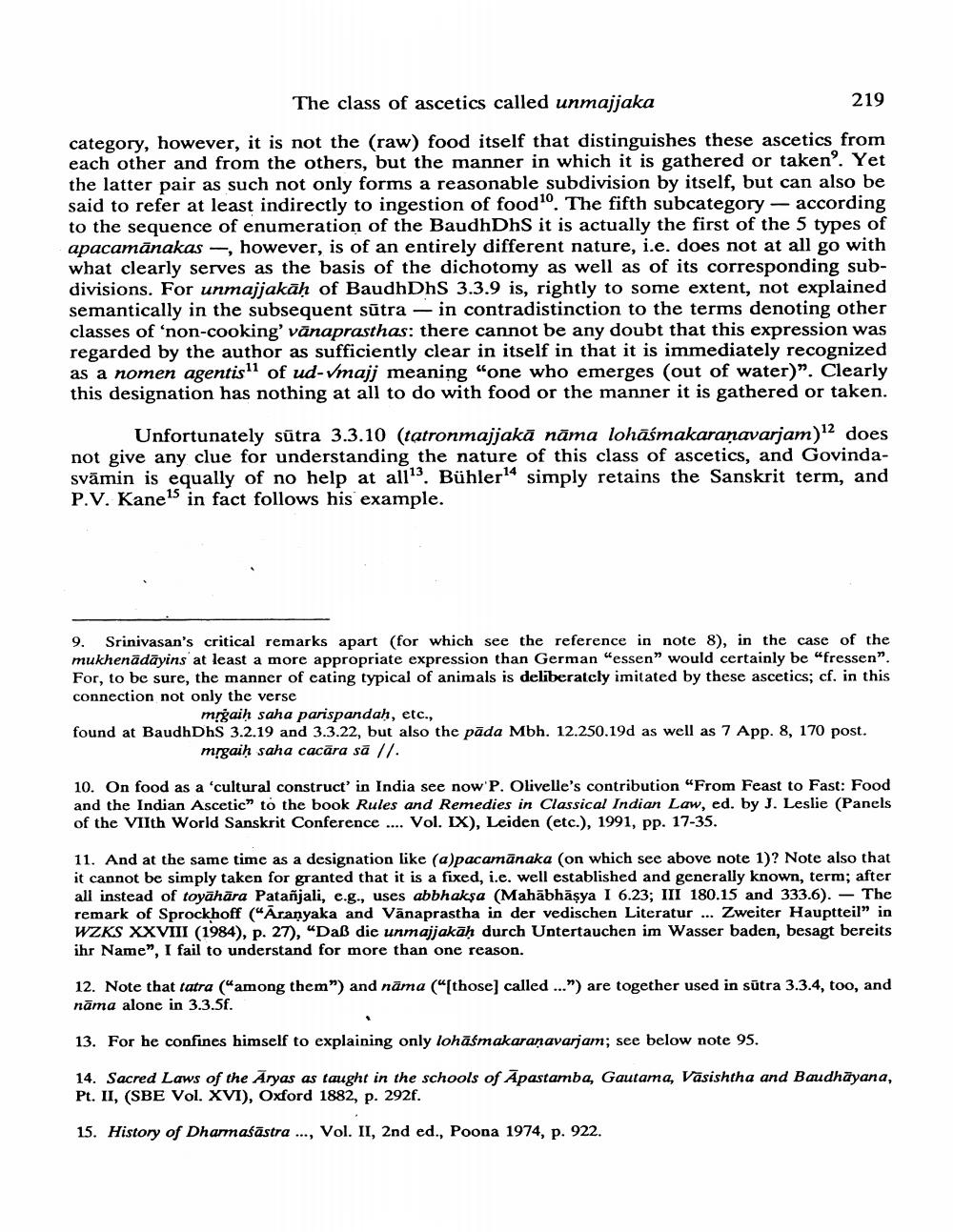Book Title: Note On Class Of Ascetics Called Unmajjaka Author(s): A Wezler Publisher: A Wezler View full book textPage 3
________________ The class of ascetics called unmajjaka 219 category, however, it is not the (raw) food itself that distinguishes these ascetics from each other and from the others, but the manner in which it is gathered or taken'. Yet the latter pair as such not only forms a reasonable subdivision by itself, but can also be said to refer at least indirectly to ingestion of food". The fifth subcategory - according to the sequence of enumeration of the BaudhDhS it is actually the first of the 5 types of apacamānakas -, however, is of an entirely different nature, i.e. does not at all go with what clearly serves as the basis of the dichotomy as well as of its corresponding subdivisions. For unmajjakāḥ of Baudh DhS 3.3.9 is, rightly to some extent, not explained semantically in the subsequent sūtra – in contradistinction to the terms denoting other classes of ‘non-cooking' vānaprasthas: there cannot be any doubt that this expression was regarded by the author as sufficiently clear in itself in that it is immediately recognized as a nomen agentis" of ud-Vmajj meaning "one who emerges (out of water)". Clearly this designation has nothing at all to do with food or the manner it is gathered or taken. Unfortunately sūtra 3.3.10 (tatronmajjakā nāma lohāśmakaraṇavarjam)12 does not give any clue for understanding the nature of this class of ascetics, and Govindasvāmin is equally of no help at all. Bühler14 simply retains the Sanskrit term, and P.V. Kane's in fact follows his example. 9. Srinivasan's critical remarks apart (for which see the reference in note 8), in the case of the mukhenādāyins at least a more appropriate expression than German "essen” would certainly be "fressen". For, to be sure, the manner of eating typical of animals is deliberately imitated by these ascetics; cf. in this connection not only the verse mrgaih saha parispandah, etc., found at BaudhDhs 3.2.19 and 3.3.22, but also the pāda Mbh. 12.250.19d as well as 7 App. 8, 170 post. mrgaih saha cacāra sā //. 10. On food as a 'cultural construct in India see now'P. Olivelle's contribution "From Feast to Fast: Food and the Indian Ascetic” to the book Rules and Remedies in Classical Indian Law, ed. by J. Leslie (Panels of the VIIth World Sanskrit Conference .... Vol. IX), Leiden (etc.), 1991, pp. 17-35. 11. And at the same time as a designation like (a)pacamānaka (on which see above note 1)? Note also that it cannot be simply taken for granted that it is a fixed, i.e. well established and generally known, term; after all instead of toyāhāra Patañjali, e.g., uses abbh akşa (Mahābhāşya I 6.23; III 180.15 and 333.6). - The remark of Sprockhoff ("Aranyaka and Vänaprastha in der vedischen Literatur ... Zweiter Hauptteil” in WZKS XXVIII (1984), p. 27), “Daß die unmajjakāh durch Untertauchen im Wasser baden, besagt bereits ihr Name", I fail to understand for more than one reason. 12. Note that tatra ("among them") and nāma ("(those) called ...") are together used in sūtra 3.3.4, too, and nāma alone in 3.3.5f. 13. For he confines himself to explaining only lohāśmakaranavarjam; see below note 95. 14. Sacred Laws of the Aryas as taught in the schools of Āpastamba, Gautama, Vāsishtha and Baudhāyana, Pt. II, (SBE Vol. XVI), Oxford 1882, p. 292f. 15. History of Dharmaśāstra ..., Vol. II, 2nd ed., Poona 1974, p. 922.Page Navigation
1 2 3 4 5 6 7 8 9 10 11 12 13 14 15 16 17 18 19 20 21 22 23 24 25 26 27
